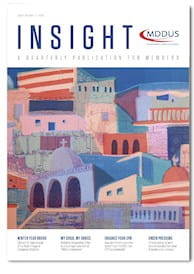
TO SAY that Mrs Gillick was angry is an understatement. She felt her rights as a parent had been undermined by a set of government guidelines issued to doctors, and she was furious. Her outrage was further fuelled by her belief that this guidance was tantamount to condoning and even encouraging underage sex.
Victoria Gillick, a mother of four daughters under 16 at the time, took legal action. What happened next would fundamentally change the way we view and assess the competence of children to make treatment decisions. Today, more than 30 years later, when we speak of consent in children and young people, we still talk of ‘Gillick competence’, but what is the story behind that phrase?
DWINDLING RIGHTS
In December 1980, the Department of Health and Social Security (DHSS) issued a circular giving guidance on family planning services for young people, which stated, or implied, that at least in certain cases which were described as ‘exceptional,’ a doctor could lawfully prescribe contraception for a girl under age 16 without her parents’ consent.
Gillick regarded this stance as illegal and in March 1981 she objected in the strongest terms to her local area health authority (AHA) — West Norfolk and Wisbech — and sought their assurance that her children would not be given advice or prescribed contraceptives without her knowledge or consent. She received no such assurance and in August 1982 she took both the AHA and the DHSS to court.
The case went initially to the High Court in 1984 where Mr Justice Woolf, who presided, turned down Gillick’s claim and dismissed the action.
He noted: “...whether or not a child is capable of giving the necessary consent will depend on the child’s maturity and understanding and the nature of the consent required. The child must be capable of making a reasonable assessment of the advantages and disadvantages of the treatment proposed, so the consent, if given, can be properly and fairly described as true consent.”
However, Gillick appealed against the ruling and the following year was successful in having this decision overturned. Against that decision, the DHSS appealed to the House of Lords in October 1985 and the case was examined by the Law Lords — Scarman, Fraser and Bridge. Gillick’s case was centred on her loss of parental rights and the legality of the DHSS’s position, and the judges reviewed these in turn.
The Law Lords examined the issue of ‘parental rights’ and concluded that these only really exist for the benefit of the child and effectively dwindle as the child grows in age and maturity. Lord Scarman stated that this “parental right yields to the child’s right” when she becomes sufficiently mature to make autonomous decisions.
The judges also firmly concluded that any doctor who exercised clinical judgement in offering contraceptive advice to a girl under 16 without her parent’s consent would not be guilty of an offence. With these rulings the decision of the Court of Appeal, which had overturned the original ruling, was itself quashed, and Gillick had finally lost.
SUFFICIENT UNDERSTANDING
This case will be remembered, however, not for what it said about the legality of offering contraceptive advice to minors, but for its more general rulings on child consent. The case afforded the judges the opportunity to address the issue of competence in those under 16 more generally, and in so doing to create the concept of Gillick competence.
Lord Scarman ruled: “I would hold that as a matter of law the parental right to determine whether or not their minor child below the age of 16 will have medical treatment terminates if and when the child achieves a sufficient understanding and intelligence to enable him or her to understand fully what is proposed.”
Thus, Gillick competence allows a child under age 16 to consent to or refuse medical treatment, and it is up to a doctor to decide whether a child has the maturity and intelligence to fully understand the nature of the treatment, the options, the risks involved and the benefits. Importantly, no lower age limit was defined in the ruling for the potentially competent child.
The nature of that “sufficient understanding and intelligence” has of course been much debated and in the absence of any clear test is likely to be somewhat subjective. However, this competence is deemed also to be ‘situation dependent’ – that is, it applies only to the treatment in question. Thus, a child may be deemed Gillick competent to understand one treatment, but not another.
This House of Lords ruling that gives the competent child the right to decide about their medical treatment has also been adopted in various Commonwealth countries and is more formally encoded in the Age of Legal Capacity (Scotland) Act, 1991.
WHICH TERM TO USE?
There has been much confusion regarding the terminology used in this area. In the 1990s there was a commonly held belief that Mrs Gillick, who had lost the appeal, objected to her name being attached to the concept of adolescent competence. As such, an alternative term ‘Fraser competence’ was introduced and widely recommended. This referred to the guidelines proposed by Lord Fraser in the same 1985 House of Lords judgement that defined Gillick competence. Unlike Lord Scarman’s ruling, these guidelines were very specifically concerned with contraceptive advice and treatment but do not have any general application; thus, the term ‘Fraser competence’ should be avoided as it is not, and never has been, a synonym for Gillick competence.
But what of Mrs Gillick’s feelings on the matter? In 2006, the author of a BMJ editorial took the entirely reasonable step of writing to ask her if she objected. Mrs Gillick replied saying she “has never suggested to anyone, publicly or privately, that [she] disliked being associated with the term ‘Gillick competent’.” Thus, Gillick competence is not only the correct but also the respectful term to use.
CONCLUSION
When treating children and young people, clinicians have an overriding duty to act at all times in their best interests. The Gillick rulings have served to clarify what can and cannot be done in this area, but they have also brought into focus the importance of involving competent children in medical decisions that will affect them. Indeed, the NSPCC reminds us that all professionals working with children must “balance children’s rights and wishes with our responsibility to keep children safe from harm”.
And what of Victoria Gillick today? Now in her seventies, she remains active. A mother of 10, and now with more than 40 grandchildren, she has continued to work and campaign against under-age sex and abortion. In 2002, she won an apology and damages in a libel case against a teenage sexual health advice charity. She claimed they had alleged that her challenge against the legality of contraception guidelines was one of the reasons for a rise in teenage pregnancies during the 1980s. More recently, she has spoken out on matters of immigration and is supportive of her husband, a former UKIP County Councillor.
Allan Gaw is a writer and educator in Glasgow
SOURCES
- Gillick v West Norfolk and Wisbech Area Health Authority and Department of Health and Social Security [1984] Q.B. 581.
- Gillick v West Norfolk & Wisbech Area Health Authority [1985], UKHL.
- Wheeler R. BMJ 2006; 332: 807. • Hayhoe B. InnovAIT 2008; 1: 764.
- www.nspcc.org.uk (Accessed Feb 8, 2018).
This page was correct at the time of publication. Any guidance is intended as general guidance for members only. If you are a member and need specific advice relating to your own circumstances, please contact one of our advisers.
Read more from this issue of Insight

Save this article
Save this article to a list of favourite articles which members can access in their account.
Save to library